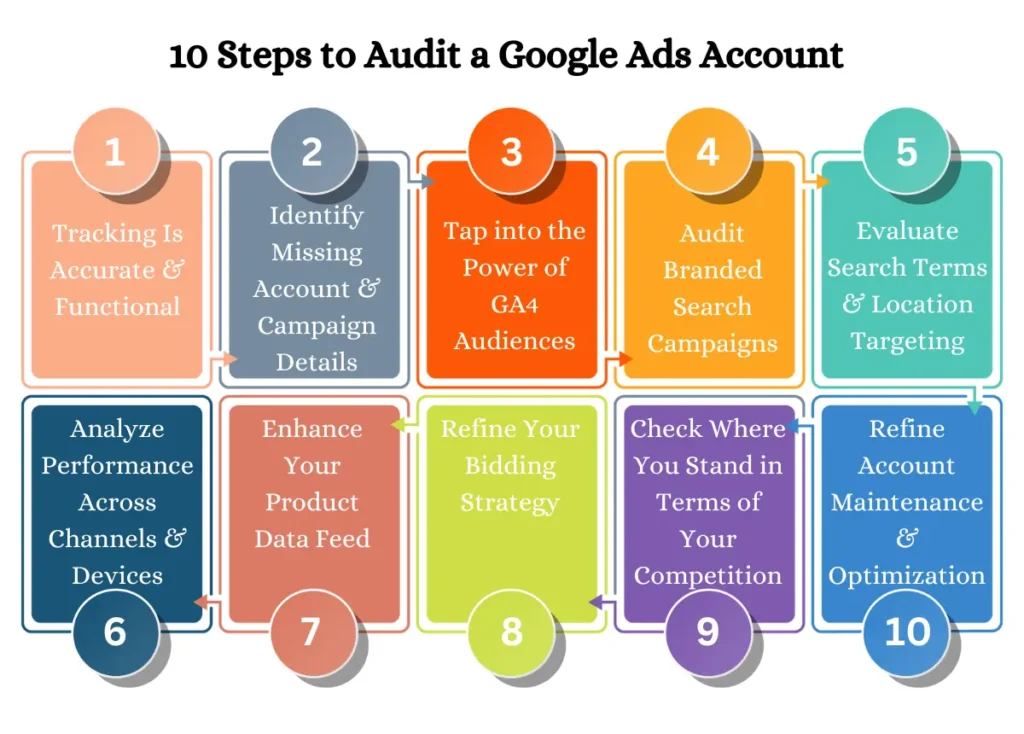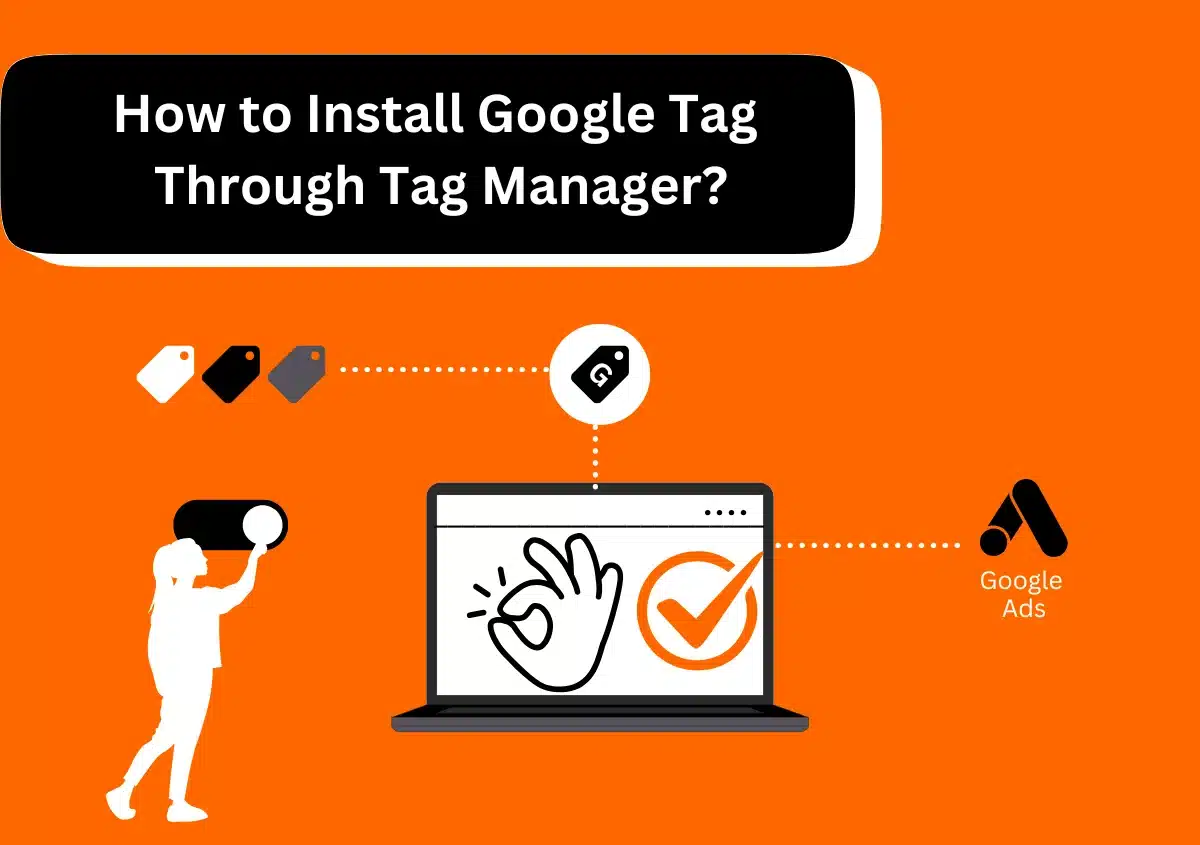You want to be confident that your ad campaign is beneficial to your business goals before investing time, money, and resources into developing it. A successful ad campaign will yield worthwhile outcomes for your business. A Google Ads account audit is the most effective method to determine whether your campaign will be successful or not.
Moreover, most tend to develop a tunnel vision when analyzing a Google Ads account that you have been managing for some time, or that of an outsourced agency.
The tendency to carry out tasks “how they have always done” can be a trap for many digital marketing teams, even if it means at the cost of increased budgets and sales. When risks aren’t taken, common mistakes are missed, optimizations are forgotten, and exploration may be abandoned.
By doing routine Google AdWords audits, all of this is preventable.
To optimize your Google Ads strategy and improve account management, a thorough Google Ads account audit can find inefficiencies and untapped possibilities.
We’ll show you how to accomplish it today.
Learn the 10 essential steps that we have compiled and then, apply these methods to your accounts right away to start seeding some ROI on your advertising spend.
Understanding the Meaning of a Google Ads Audit
An audit of your Google Ads account is the first step to take if you want to improve your ad performance. An essential part of getting to where you want to go is understanding where you are now. How wide your audit should be will depend on your available bandwidth and what you hope to learn from the analysis. The general rule is that the more detailed the review, the more valuable the information obtained from the survey. But, at the very least, your Google Ads audit should include the following:
- Evaluation of Google Search Ads campaigns
- Analysis of the Google Shopping Ads campaigns
- Comparative analysis of branded and non-branded campaigns
- Performance analysis by device
- Bid strategies review
- Analysis of ad and campaign extensions
- Optimization of negative keyword lists and location targeting
- Evaluation of ad copy in Responsive Search Ads and Performance Max asset groups
- Complete analysis of competitors
It is important to note that although Bing shares a similar advertising platform with Google, the following guide assumes that you are running PPC on Google. The fact is that search advertising is ruled by Google, and most of the conversions come from Google Ad placements. However, the momentum you gain by optimizing your strategy on Google can sometimes be enough to give you an edge over Bing.
To keep it simple, your accounts’ efficacy is assessed through a Google Ads account audit.
An audit can uncover painful hidden issues that require attention.
After you’ve determined what these problems are, you can start addressing them to enhance the performance of your ad account.
Updates to accounts or campaigns should only be made during the audit itself if you find something very important that has to be fixed right away.
Delivering a report and findings that can be incorporated into an action plan for one-time follow-up tasks and procedures for continuous management changes is crucial from the beginning to the end of the audit process.
Starting an audit that never ends and has shifting goals is the last thing you want to do.
Why Is a Google Ads Account Audit Necessary?
Important ad metrics determine how successful your Google Ads campaigns will be. You may find out how well your advertisements are doing by carrying out a thorough audit. 97% of Google Ads are unsuccessful in capturing audience attention due to low interaction.
Your marketing team will be able to make smart adjustments and raise your chances of ranking in the top 3% by determining the causes of low engagement. The following are the main benefits of performing an audit of Google Ads accounts:
- Aids in locating underperforming keywords, ad groups, campaigns, and advertising in the Google Display Network and Search. You may adjust your ad campaign to perform better and increase return on ad spend (ROAS) by evaluating the statistics.
- Reduces waste brought on by ineffective ad copy or irrelevant keywords.
- Prevents suspension or penalties by ensuring the level of your ad account conforms with Google Ad regulations.
- Enhances the effectiveness of your campaign to help your ad rank higher on the Google display network and keep you ahead of your competitors.
- Discover fresh chances to overall increase the reach of your running advertising.
- Improve current management procedures.
- Gain insights into the audience that may be targeted and other marketing platforms.
Periodically auditing your campaigns has additional advantages as it gives you a chance to stand back and see things that you may have overlooked in day-to-day operations.
For this reason, having a Google Ads audit is beneficial.
10 Steps to Audit a Google Ads Account in 2024

We’ll go over the fundamentals as well as the more complex methods in the step-by-step guide that follows.
If you want to assess the account structure and campaign settings for your own business, this Google Ads audit checklist is an excellent place to start.
Step 1: Ensure Your Tracking Is Accurate and Functional
First and foremost, before you do any analysis work, make sure all your tracking systems are running properly. Believe us, issues with analytics are much more common than you think.
Our first piece of advice is to rigorously inspect your analytics setup. Start by making sure your Google Ads accounts are fully linked with your Google Analytics 4 accounts. Then check your conversion tracking, which is especially relevant with the new GA4 system, for double-tracking and missing data. A surefire way to assess your tracking setup is to make test orders yourself.
By deliberately clicking on your ad and completing an order, you can compare how that transaction is recorded in both Google Analytics and Google Ads.
Keep an eye out for a high “repeat rate” metric, as it could signal potential issues with double-counting conversions, depending on the nature of your products or services.
Sometimes, uncovering these discrepancies necessitates a fresh perspective. That’s why we recommend enlisting the expertise of a third-party professional, such as a contractor or agency, to conduct a thorough review of your setup. They can often pinpoint errors that your in-house team might overlook.
Step 2: Identify Missing Account and Campaign Details
While ensuring your analytics setup is relatively sound, it’s paramount to conduct a more thorough review of your campaigns and ad sets. Fortunately, Google Ads also gives explicit recommendations on the required information and tasks to have a robust account setup.
Start with Google’s guidelines to understand your current setup.
Pay attention to missing elements or areas that can be improved in your campaigns and ads: Site links, Account, and ad extensions, e.g., price and phone call extensions, image extensions, callouts, structured snippets, business name & logos, and more.
Having the extensions for all the campaigns significantly increases the effectiveness of your ads. Without them, your ads may not be placed ideally, which increases your total costs to have a lower ad rank. In your account review, notice missing extensions and those you are using only at the account level. In most cases, campaign-specific and sometimes ad-group-specific extensions are better. However, some extensions may not be available on all campaign types — for instance, some aren’t accessible for Shopping campaigns. Account-level extensions are usually the easiest part of Google Ads audit to address — low-hanging fruit. However, whether you try to fix it promptly is your decision. We’d recommend creating a thorough list initially and then prioritizing improvements based on your team’s capacity and the most significant opportunities.
Step 3: Tap into the Power of GA4 Audiences
Universal Analytics was retired in the summer of 2023, and its associated UA audiences were phased out as well. However, so many Google Ads accounts are fully based on them still. That is, for this reason, it is crucial to use the new audience sets in Google Analytics 4 for a more complete understanding of your audience. Once you’ve linked your GA4 account to Google Ads, you will get access to two options. The first is to create most of your UA audiences in a new GA version. The second is to let an analytical system utilize its predictive capabilities, providing audiences that include such forecasts as:
- Seven-day churning purchasers
- Seven-day churning users
- Seven-day purchasers
- First-time seven-day purchasers
- Predicted 28-day top spenders
By using updated audience sets, you will gather insights on your audiences, helping you improve targeting to make your advertising efforts more productive.
Step 4: Audit Branded Search Campaigns
Now, with the building blocks of your Google Ads in place, it’s time to focus on one of the most profound touchstones of your search marketing edifice — your brand campaigns.
Branded search campaigns are the point where paid search and SEO strategies meet. While the latter covers the organic part of the search engine results page, the former ensures your website remains visible on the paid side via specific high-intent keyword bidding.
Indeed, branded search campaigns more often than not become a cost-effective part of your overall Google Ads strategy. However, missed bids may result in your competitors overtaking your branded search and stealing potential customers — the ones who are actively looking to find you online. To audit your branded campaigns, perform the following steps:
Prevent Self-Competition
To prevent disproportionally triggering search terms for both your branded and general campaigns, go to your Search Terms Report. When some search terms consistently trigger both campaign types, it tends to perform poorly over time while raising your bid prices across the board. Smartly use the negative keywords to your campaigns, and develop a bidding strategy, enabling you to align up these inefficiencies and expenses.
Outmaneuver Competitors
Utilize Google’s Auction Insights tool to determine which competitor is trying to get your branded keywords on the SERP. Focus on metrics like impression share and overlap rate. You will have to try, find a plan, and bid high enough to outperform the most intense competitors in the SERP. If you need fresh ideas, please consult our complete guide on Google Ads competitor analysis.
Detect Misspellings
Most search marketers understand the importance of owning brand terms but rarely realize that brand misspellings are just as useful. Use relevant misspellings in your campaigns regardless of how simple or confusing your brand name is.
For instance, if your brand is AcuTune, you should also ensure that you bid on misspelled brand keywords like “ acutun,” “acutune,” “akutune,” etc. When you buy misspelled brand keywords, you will also be able to reach more interested users and generate revenue.
Eliminate Irrelevant Brand Terms: Dig deeper into your branded terms outside the general ones after other campaigns secure the most relevant visibility. Then again, dive back into the search terms and filter to identify the offending terms, such as “company ownership,” “stock value,” “contact details,” etc. Since search terms indicated existing interest from the person and possibly their customer status, you almost definitely do not want to buy the click due to the low intention.
Step 5: Evaluate Your General Search Terms and Location Targeting
Your more general search campaigns, especially in terms of keywords and targeting, are next in line for review after your branded search campaigns.
Investigate search terms and triggered ads. Just like with branded search, go into your Search Terms Report, and find which keywords are linking to which ads. Again, enhance the report, adding separate columns, and ask yourself the following to get an idea of how your general search term campaigns contribute to your goals:
Are your set match types delivering your chosen search terms effectively?
Do you need to pause broad or phrase-match keywords?
What search terms should be added to your negative keyword list? In our experience, let’s say an online store is focused on high-end skincare products, and you’ve bid on terms such as “luxury serums” but bid against queries such as “most exclusive skincare serums” or “best serums for your skin type.” While these queries were technically under the terms you are bidding on, if they didn’t help you achieve your goals, you need to make the necessary adjustments.
Review your negative keyword list. Make sure you triple-verify your campaign negatives and in your negative keyword list.
Ensure your negatives are properly set up at the campaign level, ad group level, and overall account level. This way, the most relevant ads will appear for a wide range of searches, ensuring you aren’t wasting money on irrelevant search terms that won’t bring you business. If you’re a mattress company, for instance, the last thing you want is for your campaigns to be triggered by searches like “sleep” and “pillows.” You should stick to high-intent searches with your bid, leaving general terms to companies with larger budgets. To take it a step further, consider creating negative keyword lists for competitors, and locations, from competitor misspellings to other brand names that sound or read similarly.
Review negative location targeting. If your service is domestic to the U.S., don’t let your campaign go international if it is not on purpose.
Use Google Analytics to break down traffic acquisition by source. Then, break down the data by country and download the list. Review which countries provide irrelevant traffic and add them in bulk to the campaigns’ negative location targeting.
Step 6: Analyze Performance Across Channels and Devices
While many of our clients use multiple channels to market their offerings, it’s important to realize that audiences from different devices and channels tend to behave differently. It is critical to know where your conversions are coming from. Here is how to fully optimize your Google Ads strategy:
Analyze Your Device Segmentation.
Whether or not you should prioritize one type of conversion with your paid search efforts depends largely on your customers’ purchasing behavior. If most of your conversions come from one device first, make conversions on the other device your primary focus. Keep the first for mostly top-of-funnel targeting and information-gathering. For example, if your mobile campaigns perform better than your desktop campaigns, a higher proportional budget should be directed there to squeeze the mobile conversions channel until it reaches peak performance. If your business focuses on products that require significant individualized customization before purchasing, there may be a barrier to purchasing on mobile. In this instance, you would want to prioritize desktop campaigns and conversions.
You can easily check device performance in Google Analytics 4. In “Reports,” go to the “Tech” dropdown, and you will see the “Overview” tab, which is a high-level overview of all device metrics. You can also click on “Tech Details” to explore more.
Create a custom report with “Device Category” at the top, and add a second dimension, “Session source/medium.” Apply a CPC filter.
Remember, eCommerce is a multi-touch journey. Clients that sell higher-end electronics and home furnishings, for example, typically experience a long journey where you discover products conduct research on a mobile device, and ultimately end up purchasing on your desktop. To maintain your product discovery traffic and desktop purchase traffic, you must always drive traffic through organic, direct, and email channels.
In essence, don’t shoot from the hip and only use Google Ads numbers. Before optimization, understand how mobile traffic contributes to site visits.
Consider Offline Conversions.
Many customers do not convert the same day they click on an ad. Some never convert online and call a customer service line.
Step 7: Enhance Your Product Data Feed

Although many eCommerce brands believe that their Google Merchant Center product data feed is not important, they do not know what they are missing. They simply focus on Google Shopping Ads, the least significant element of an eCommerce ads campaign, by concentrating solely on ad text and keywords.
How should you pay attention to the following? Your product title and description. The moment you include in your product title and description will have an impact on how Google will display your product in search results. Therefore, it is important to provide Google with a lot of information about the products but only in a limited space and to update it all the time to get better results.
How to mention the product in your title and description? Make titles and descriptions properly informative and focus-based. A subpar title will make a product not appear when a shopper records a search and fails to encourage him to finalize a purchase. Try to get creative while writing a product description, but not too much – if Google can’t understand it, it might score your product low. Make it a little bit clinical, easy to read, and descriptive. The following information should be included in all listings; if something is missing, add it. Find what the best practices for this information are by looking at current search results. Compare your products on Google Shopping to your competition’s offerings. Make changes to your product page accordingly to avoid future mistakes.
Keep Your Product Stock and Inventory Updated.
With the current uncertainty surrounding product supply chains, it is essential to keep updating out-of-stock products to prevent wasted ad spend. Even though Merchant Center derives inventory details directly from your site, your Google Search Ads campaigns will still run unless you pause them for out-of-stock products. To avoid losing revenue from advertising products that are out of stock, you could offer backorder or preorder options for consumers or direct consumers to products related to but not the same as what they originally wanted. If one product is unavailable for an extended period, contemplate pausing that ad.
Correct any GMC Errors.
It is important to note that the Google Merchant Center will indicate what is wrong with your ad accounts. It may highlight products that are not serving at all or serving in a limited capacity. Some of the explanations may include non-functional landing pages or no key product information. Therefore, these errors should be corrected during the Google Ads audit, and a plan should be developed to handle them swiftly in the future. This way, the Google Shopping Ads will continue running effectively.
Step 8: Refine Your Bidding Strategy
Finally, the performance of your Google Ads campaigns will significantly depend on your bidding strategy. However, coming up with a perfect strategy may take some time and requires making small real-time adjustments to perfect it. On your Google Ads audit, these are the steps to avoid:
- Only relying on Google’s automatic bidding
- Forgetting to optimize your budget allocation based on the time of the day
- Not bidding on your competitor’s branded queries.
In our experience, a good strategy for most brands includes a combination of manual and automatic bidding. However, you will need to experiment with different ratios to find the optimal one for your business. The choice will depend on your goals, the amount of control you need, trust in Google’s algorithms, and the volume of traffic/conversions to allow its algorithms to optimize most of the time. Nonetheless, you can run experiments to choose the best strategy if you are uncertain. Just split-test different bid strategies, allocating 50% of the budget for each, and measure the results after a few weeks. Then, adjust your campaigns accordingly to find the best one that helps you reach your goals.
Step 9: Check Where You Stand in Terms of Your Competition
While you’re analyzing your Google Ads campaigns, see how well your competitors are performing. Please remember that instead of focusing on a certain brand, take a look at the larger perspective of your industry. As Google no longer offers the amount of information it used to, competitor research becomes harder. Still, we think it actually benefits most brands, as it allows you to concentrate on the bigger picture rather than individual tactics.
Use the Following Tools to Get a Sense of Your Vertical Landscape:
Keyword Planner – it will show you which important keywords are popular now, as well as a general, often understated bid estimate to rank for them.
Google Merchant Center’s Best Sellers – it will show you what products are hottest in your vertical so that you can adjust your product strategy and your campaigns accordingly.
Google Ads Campaign Target ROAS Simulator: It will show you how your (and your competitors’) current ad spending trend will affect your actual conversion goals and how much extra ad budget you’ll have to spend to achieve them.
Step 10: Refine Account Maintenance and Optimization
Now that’s out of the way, let’s go over a few of the more minor things you should keep an eye on in your healthy Google Ads account. These are not the most vital aspects of your campaign’s success, but they have a minor impact on the overall health of your account. Some of them can even drive insight that you have never considered, making you a wiser marketer in the process:
Change History
Change history serves as a record of account activity. You can browse through it to determine the amount of work being done. Account managers may not directly benefit from this information. Still, it is enlightening for audits of agencies or employees, giving you a peek into the account management space and the best practices being implemented.
Display Placements
When you are targeting the audience beyond placements, monitor where your ads are going. Display Placements helps you view the clicks and impressions on different websites and apps. Exclude the placements with clicks and no conversions and focus on those placements that match your goals. Be sure to watch out for mobile gaming placements that do not yield high-quality clicks.
IP Exclusions
Do you think a competitor or an employee is clicking on your ad? Use IP exclusions to stop them. Exclude an entire IP address to protect your ad spend from invalid clicks.
Automation
Various tools can help you streamline your campaign management processes, from simple automated rules to customized Google Ads scripts. These tools enable you to handle bids and carry out strategic optimizations with minimal input from you. Automation helps you get ahead no matter the cause.
Conduct Google Ads Audit Now
To get the best return on investment, you must regularly evaluate the effectiveness of your advertisements. Identify strengths and weaknesses in your ad campaign with a thorough audit for data-driven decisions.
We hope the aforementioned Google Ads audit checklist will assist you in addressing every important aspect that affects the performance of your ad group and account, such as budgeting, targeting, bidding strategies, ad content, conversion tracking, and more.
For an effective and in-depth Google Ads account Audit, contact our Website Pandas team today!













